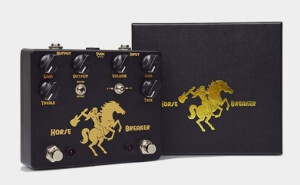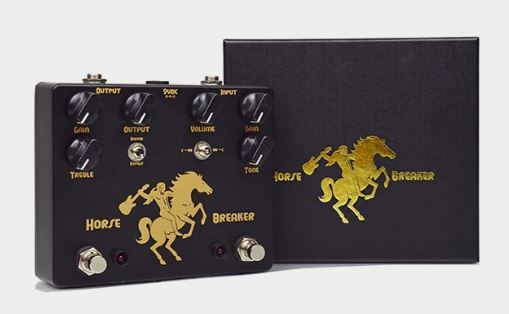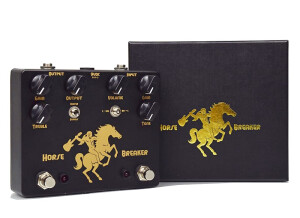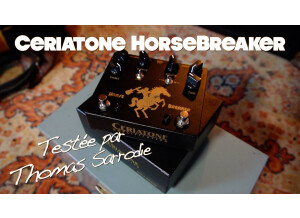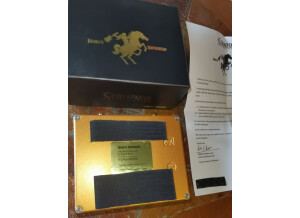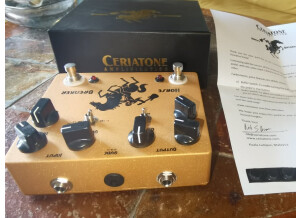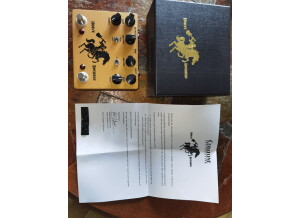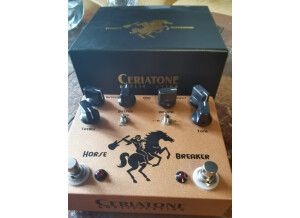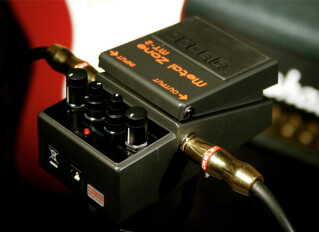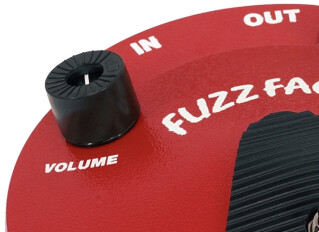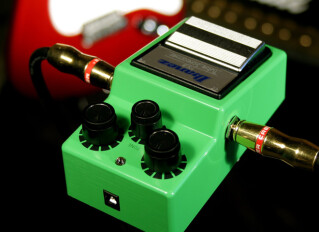Horse Breaker classified ad
New ad alertImages
Reviews
5.0/5(1 reviews)
100 %
Write a user review
Merging the Centaur with the Bluesbreaker, a Plethora of Tone is Yours for the Taking
Published on 03/29/20 at 05:15BACKGROUND:
Take two of the most popular drive pedals, the Klon Centaur and the Marshall Bluesbreaker, and combine them into one pedal that allows each to function separately or together and you have the Horse Breaker. There are a lot of tones emanating from this pedal and they vary even more whether working with a clean or dirty amp. Generally speaking, the drive ranges from modest and warm (Breaker) to medium-high-gain and edgy (Horse). What makes the Horse Breaker so diverse, however, is the ability to blend the two sides and in different amounts (via the Drive and the Volume/Output of each) and to cascade one into the other, e.g., Horse pushing Breaker or Breaker pushing Horse.
...…
Take two of the most popular drive pedals, the Klon Centaur and the Marshall Bluesbreaker, and combine them into one pedal that allows each to function separately or together and you have the Horse Breaker. There are a lot of tones emanating from this pedal and they vary even more whether working with a clean or dirty amp. Generally speaking, the drive ranges from modest and warm (Breaker) to medium-high-gain and edgy (Horse). What makes the Horse Breaker so diverse, however, is the ability to blend the two sides and in different amounts (via the Drive and the Volume/Output of each) and to cascade one into the other, e.g., Horse pushing Breaker or Breaker pushing Horse.
...…
Read more
BACKGROUND:
Take two of the most popular drive pedals, the Klon Centaur and the Marshall Bluesbreaker, and combine them into one pedal that allows each to function separately or together and you have the Horse Breaker. There are a lot of tones emanating from this pedal and they vary even more whether working with a clean or dirty amp. Generally speaking, the drive ranges from modest and warm (Breaker) to medium-high-gain and edgy (Horse). What makes the Horse Breaker so diverse, however, is the ability to blend the two sides and in different amounts (via the Drive and the Volume/Output of each) and to cascade one into the other, e.g., Horse pushing Breaker or Breaker pushing Horse.
SOUND & OPERATION:
The Horse Breaker sounds great with any amp, and I used it with the AMP1 Iridium (all four channels) as well as all three Victory V4 Preamps. The Horse Breaker does not sound ostentatious, but tends to excite the tone already inherent in the amp. Consequently, if you like the tone of your amp, you will love it with the Horse Breaker trotting alongside. On a clean channel the Breaker side sounds thick and warm, and when pushing the Drive it has that amp-breaking-up quality. It offers some mild overdrive (just above a clean boost in quality) to some classic Rock tones. Also when working with a clean amp, the Horse side has a well-defined grain or dirt that has a harder Rock sound, although bordering on the modern; ideal for heavier crunch and lead. Neither side sounds over-saturated with its Drive up high, even when combined with higher-gain amps, which was surprising. When working with dirty amp channels, the Horse Breaker does an incredible job at supercharging the signal without creating a mess. It only takes a bit of Horse or Breaker (or both if you like to blend) to make a significant difference with a richer tone that pops in the mix. In the demo below I added the Horse Breaker to three Victory preamps: The Sheriff, The Countess and The Kraken. I kept the Horse Breaker at low levels to enhance the ‘cleans,’ but the quality and difference was as significant when pushing the dirty channels at slightly higher drive levels.
Combining the two sides offers a lot of potential, particularly if you’re not quite sold on the Horse or the Breaker on their own. For example, if finding the Breaker side a touch subdued, adding a bit of Horse increases the tight mid and high-end sizzle. A hardened Breaker tone is more pronounced if you have the Breaker running into the Horse, whereas the Horse’s character shines through more when it runs into the Breaker. Obviously, then, if the Horse sounds too aggressive, you can add some Breaker to soften and fatten the edges. Just how much you blend varies considerably, since you can control the Drive and Level on each side. And so, the Horse may be dominant when running into the Breaker, but if you have more Breaker Drive and Level (and not much Horse), then the Breaker will dominate, but in a different way than if the Breaker ran into the Horse. If that seems unclear, do refer to the first demo of this review. Regardless of the combination, the Horse Breaker does not sound muddy or with unwanted saturation. Even at high drive levels the signal remains defined and clear.
The Tone knobs on both sides are not excessive in range, offering some lower end or higher end, which sounds more like a broad mid-range EQ than it does full range with a lot of bass or treble potential. Nonetheless, a slight tweak makes a significant difference in tone, and so Ceriatone really nailed the electronics right, in how the Tone works with the Drive.
Now, there are several ways to use the Horse Breaker, but one consideration is to use the Breaker side for a solid and thick rhythm tone and then engaging the Horse for more intense crunch tones and lead. In doing so, you can set the Horse side for a modest boost while also increasing the overall drive. The opposite can be done, in that the Horse can supercharge your rhythm and then adding the Breaker brings in some thick cream for those leads. And for those who like to stack pedals, the Horse Breaker plays very nicely. I added each side of the Horse Breaker independently and blended (low to moderate drive levels) with other drive pedals (at various mixes) and the clarity and quality of the Horse Breaker shone through brightly and vividly.
The Horse Breaker is rugged in build, with a metal chassis powder-coated black with gold lettering (also available in gold with black lettering). You can operate it in Buffer or True Bypass mode at the flip of a switch. The Horse Breaker operates on a 9VDC battery or via a standard 9VDC (negative tip) power supply, drawing under 100mA.
LIMITATIONS:
The Horse Breaker sounds great, and so there is very little to fault with its tone (or should I say ‘tones’). However, if you’re not sold on either a Klon Centaur or a Marshall Bluesbreaker, you may not be satisfied – although you may be once you start blending the two. Measuring 5.5 (w) x 4.85 (d – including jacks) x 1.35 inches (h) or 139.7 x 123.19 x 34.29 mm, the Horse Breaker is larger than a standard pedal, although it is two pedals in one. If you’re tight for pedal board space, then the Horse Breaker may not be suitable, but you always could replace pedals you think are mediocre and make way for something truly awesome and tone-inspiring.
Take two of the most popular drive pedals, the Klon Centaur and the Marshall Bluesbreaker, and combine them into one pedal that allows each to function separately or together and you have the Horse Breaker. There are a lot of tones emanating from this pedal and they vary even more whether working with a clean or dirty amp. Generally speaking, the drive ranges from modest and warm (Breaker) to medium-high-gain and edgy (Horse). What makes the Horse Breaker so diverse, however, is the ability to blend the two sides and in different amounts (via the Drive and the Volume/Output of each) and to cascade one into the other, e.g., Horse pushing Breaker or Breaker pushing Horse.
SOUND & OPERATION:
The Horse Breaker sounds great with any amp, and I used it with the AMP1 Iridium (all four channels) as well as all three Victory V4 Preamps. The Horse Breaker does not sound ostentatious, but tends to excite the tone already inherent in the amp. Consequently, if you like the tone of your amp, you will love it with the Horse Breaker trotting alongside. On a clean channel the Breaker side sounds thick and warm, and when pushing the Drive it has that amp-breaking-up quality. It offers some mild overdrive (just above a clean boost in quality) to some classic Rock tones. Also when working with a clean amp, the Horse side has a well-defined grain or dirt that has a harder Rock sound, although bordering on the modern; ideal for heavier crunch and lead. Neither side sounds over-saturated with its Drive up high, even when combined with higher-gain amps, which was surprising. When working with dirty amp channels, the Horse Breaker does an incredible job at supercharging the signal without creating a mess. It only takes a bit of Horse or Breaker (or both if you like to blend) to make a significant difference with a richer tone that pops in the mix. In the demo below I added the Horse Breaker to three Victory preamps: The Sheriff, The Countess and The Kraken. I kept the Horse Breaker at low levels to enhance the ‘cleans,’ but the quality and difference was as significant when pushing the dirty channels at slightly higher drive levels.
Combining the two sides offers a lot of potential, particularly if you’re not quite sold on the Horse or the Breaker on their own. For example, if finding the Breaker side a touch subdued, adding a bit of Horse increases the tight mid and high-end sizzle. A hardened Breaker tone is more pronounced if you have the Breaker running into the Horse, whereas the Horse’s character shines through more when it runs into the Breaker. Obviously, then, if the Horse sounds too aggressive, you can add some Breaker to soften and fatten the edges. Just how much you blend varies considerably, since you can control the Drive and Level on each side. And so, the Horse may be dominant when running into the Breaker, but if you have more Breaker Drive and Level (and not much Horse), then the Breaker will dominate, but in a different way than if the Breaker ran into the Horse. If that seems unclear, do refer to the first demo of this review. Regardless of the combination, the Horse Breaker does not sound muddy or with unwanted saturation. Even at high drive levels the signal remains defined and clear.
The Tone knobs on both sides are not excessive in range, offering some lower end or higher end, which sounds more like a broad mid-range EQ than it does full range with a lot of bass or treble potential. Nonetheless, a slight tweak makes a significant difference in tone, and so Ceriatone really nailed the electronics right, in how the Tone works with the Drive.
Now, there are several ways to use the Horse Breaker, but one consideration is to use the Breaker side for a solid and thick rhythm tone and then engaging the Horse for more intense crunch tones and lead. In doing so, you can set the Horse side for a modest boost while also increasing the overall drive. The opposite can be done, in that the Horse can supercharge your rhythm and then adding the Breaker brings in some thick cream for those leads. And for those who like to stack pedals, the Horse Breaker plays very nicely. I added each side of the Horse Breaker independently and blended (low to moderate drive levels) with other drive pedals (at various mixes) and the clarity and quality of the Horse Breaker shone through brightly and vividly.
The Horse Breaker is rugged in build, with a metal chassis powder-coated black with gold lettering (also available in gold with black lettering). You can operate it in Buffer or True Bypass mode at the flip of a switch. The Horse Breaker operates on a 9VDC battery or via a standard 9VDC (negative tip) power supply, drawing under 100mA.
LIMITATIONS:
The Horse Breaker sounds great, and so there is very little to fault with its tone (or should I say ‘tones’). However, if you’re not sold on either a Klon Centaur or a Marshall Bluesbreaker, you may not be satisfied – although you may be once you start blending the two. Measuring 5.5 (w) x 4.85 (d – including jacks) x 1.35 inches (h) or 139.7 x 123.19 x 34.29 mm, the Horse Breaker is larger than a standard pedal, although it is two pedals in one. If you’re tight for pedal board space, then the Horse Breaker may not be suitable, but you always could replace pedals you think are mediocre and make way for something truly awesome and tone-inspiring.
See less
10
»
Tech. sheet
- Manufacturer: CeriaTone
- Model: Horse Breaker
- Category: Other guitar saturation effects
- Added in our database on: 03/29/2020
We have no technical specifications for this product
but your help will be much welcomed
»
Other categories in Saturation effects pedals
Other names: horsebreaker


